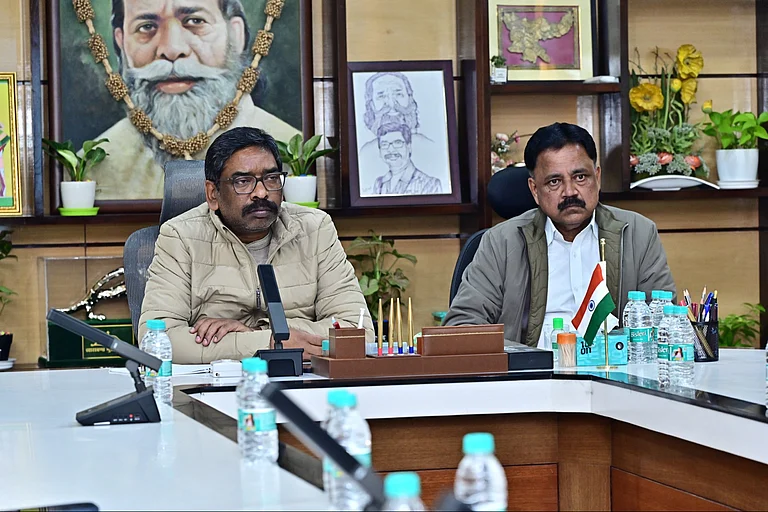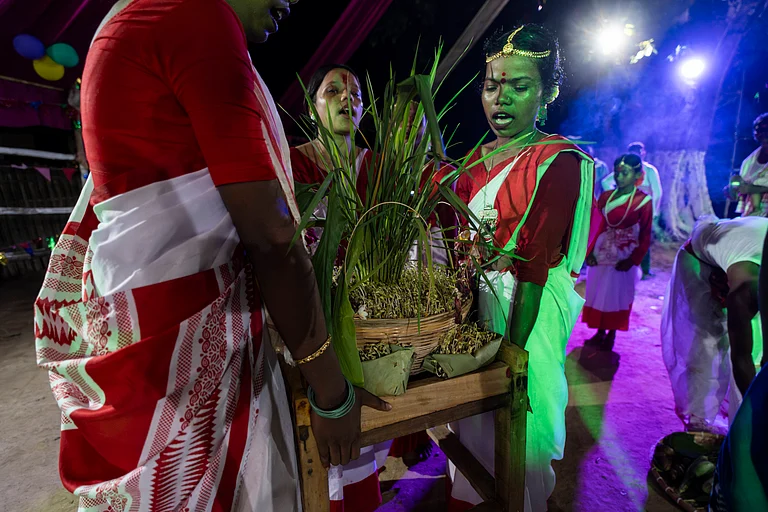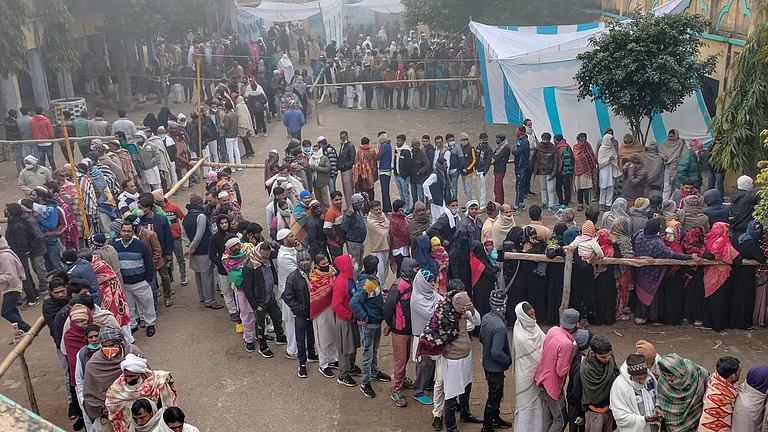
A high-pitched battle awaits as we inch closer to the 2024 Lok Sabha election scheduled to be held in seven phases from April 19 to June 1. The last five years, BJP-led National Democratic Alliance's second term, saw a series of civil protests, political cross-firings and constitutional debates. At Outlook, we are closely tracking the developments and bringing to you exclusive stories, ground reports and in-depth analysis of the state-wise electoral scenario, focusing on regional parties, their journeys in recent years and how it will play out at a national level.
Today, we are looking at Jharkhand which has witnessed a significant shifts in the run-up to the polls with the arrest of Hemant Soren earlier this year. The NDA will look to replicate its 2019 performance in the state while the Jharkhand Mukti Morcha and Congress-led INDIA bloc look to ride on its support from tribal communities, which forms the nucleus of Jharkhand's voter base. As the state goes to polls from May 13, here are the major parties and key factors that will play a crucial role in the coming days.
Gao chorab nahi ladai chorab nahi,
Maye mati chorab nahi ladai chorab nahi....
Composed by filmmaker Megnath and sung by Padmashree Madhu Mansoori, this song someway or other captures the struggles of Jharkhandi people. Literally meaning that ‘Neither we would leave our land, nor our village and struggle to protect them’- these words became the war cry for Jharkhand statehood movement. During 1970s the movement that consolidated Adivasis against moneylenders, workers against the industrialists and Adivasis against the Dikus culminated in a movement for separate statehood. And when the state came into existence in 2000, it turned out to be a political hotbed- where most of the mainstream political parties wanted to have its hold.
Though the state has only 14 Lok Sabha seats- minuscule in contrast to the bigger states like Maharashtra, UP or West Bengal- the eyes of national parties have been glued to it. In words of the current Chief Minister and senior JMM leader, Champai Soren- “We have 40% of mineral resources of India. And this is one of the major reasons that everybody is interested in us.” This is one of the major reasons that the BJP is trying to discredit the leadership of former CM Hemant Soren, who has recently been arrested by ED for his alleged role in a land grabbing case, adds the CM.
The arrest of Soren, a popular Adivasi leader and son of Dishom Guru Shibu Soren, one of the most respected figures in the state, was not received well by Adivasi organizations across the state. While some of them said that it is an attack on Adivasis, Soren himself on the floor of the house during the no-confidence motion said, “They want us to go back to jungle. They can’t digest Adivasis riding BMW.”
The BJP’s campaign against the alleged ‘corruption’ and dynastic politics of Soren family has become stronger with Loksabha elections knocking on the door, author and Adivasi scholar A K Pankaj says, “They are feared of Adivasis across the country. Look at Uttarakhand. They passed the UCC but they exempted Adivasis out of the fear of resistance.” This viewpoint is shared by some senior JMM leaders as well. “The idea of uniting Adivasis through Sarna and Soren’s efforts to address the concerns of Jal Jungle Jameen have irked the ruling party,” says Champai Soren.
Since coming to power in 2019- for the first time with a formidable majority of 47 seats out of 81 assembly seats- the JMM-Congress-RJD coalition government both symbolically and politically worked towards pushing issues that matter to Adivasis and precisely Jharkhandis.
In 2020, Soren government passed a resolution on Sarna code bill and asked the central government to give Adivasis a separate religious column in the upcoming census. They also asked the central government to place it within tenth schedule to avoid the judicial scrutiny.
In 2022, the JMM-led government passed the much-awaited domicile policy that promised to give priorities to the residents of Jharkhand who have been staying in the state since or before 1932. Along with that his government also declared 27% reservation for the OBCs- another constituency that the JMM-led coalition government has been trying too for years. However, the general secretary of JMM Supriyo Bhattacharya, says, “Jharkhand had 27% reservation policy for the OBCs but in 2001 Babulal Marandi abolished it and reduced it to 14 percent. We have only corrected it and JMM has a policy of taking everyone from the beginning”.
“All of these besides the works done by the ruling government in favour of the marginalized made the BJP uncomfortable. In every century, some Adivasi leaders emerge and resist and every time, ‘they’ would come to restrain us,” says the current CM.
But why is BJP so invested in a small state that has just 14 Loksabha seats and where most of the time they performed pretty well barring 2004? A senior journalist says, “There are two factors. Firstly, BJP’s efforts to address the Adivasi constituencies across the country was getting affected due to strong presence of Soren-the leader of the only Adivasi party in northern India. They were unable to establish their dominance in front of Soren’s resistance.” And secondly, they paid huge price for non-Adivasi CM Raghubar Das’s efforts to meddle with the CNT and SPT acts that have huge emotional connection to Adivasis. “And all of those mistakes of Das were rectified by Soren as he consolidated the Adivasis under the umbrella of Sarna- the effects of which might spill over to other state,” he says.
It was one of the major reasons for the party to install an Adivasi CM Vishnu Deo Sai in Chhattisgarh after they won a comfortable victory in the latest round of assembly elections. In the last few months, the BJP also was found wooing the Adivasi constituency with projects worth Rs 20,000 crores targeting at PVTGs. Interestingly, the PM launched it from Birsa Munda’s village in Jharkhand on the iconic Adivasi leader’s birth anniversary.
The evocation of Adivasi characters in the Ramayana during PM Modi’s speech after the inauguration of Ram Mandir, also was an effort to signal the community, think scholars. With around 27% tribals according to 2011 census, Jharkhand is the second largest Adivasi-dominated state after Madhya Pradesh.
In 2019, BJP and All Jharkhand Students’ Union (AJSU) together won 12 seats out of 14 where the former received 51.6% vote share. JMM and Congress won 1 seat each. However, in the assembly elections- just after a few months of BJP’s sweep- JMM gave their best performance since the party’s electoral inception in 1980. For the first time, JMM got 26 out of 28 reserved ST seats. “The party expects to repeat its performance this time,” says Champai Soren.
However, for the last few months, all is not well with JMM. Recently, Hemant Soren’s sister-in-law and senior JMM leader Sita Soren jumped the boat and joined BJP. Lobin Hembram, an MLA and senior party leader notes, “She left the family. Things are not going well. People are not much happy with this government.”
He also adds that if he doesn’t get ticket, he would fight as an independent. “This government even after 4 and half years couldn’t implement domicile policy and this is not received well by Adivasi and moolvasi communities. I am a well-wisher of the party and believe that still there is time for course correction,” says the disgruntled MLA.
Amidst these discontents, while BJP has declared the names of all the candidates, JMM-Congress-RJD alliance only could clinch a deal in three seats. Among the 14 seats, there are a few big battles to lookout for.
The most significant seat in the current political situation in the state is Dumka. There is a possible fight between two daughters-in-laws of Soren family in this seat. BJP though earlier had declared its previous MP Sunil Soren the candidate from this seat, as soon as Sita Soren jumped the fence, the party gave ticket to her. Dumka has been a traditional seat of JMM from where Shibu Soren won his first elections in 1980. Though there is a buzz that Hemant Soren would fight this seat himself from jail, sources said that Kalpana Soren, Hemant’s wife could also be the candidate.
Another major seat to lookout for is Chaibasa where Geeta Koda, who won this seat in 2019 from Congress is fighting from BJP. Interestingly, Geeta Koda is the wife of former Jharkhand CM Madhu Koda who as an independent candidate formed the state government with support from BJP. Khunti would also witness some interesting contests as Union Minister Arjun Munda is going to have a tough contest. In last Loksabha elections, Munda won it only after recounting.
While these contests would be closely followed, the campaigns around Jal Jungle and Jameen are getting strengthened and Kalpana Soren is emerging as the new leader of the party. Still, “the discontents cannot be avoided. The upper crust of JMM is full of outsiders and non-Adivasi leaders and that would not help the party,” laments Hembram.
The state will go to polls in four phases- spreading from May 13 to June 1.





























